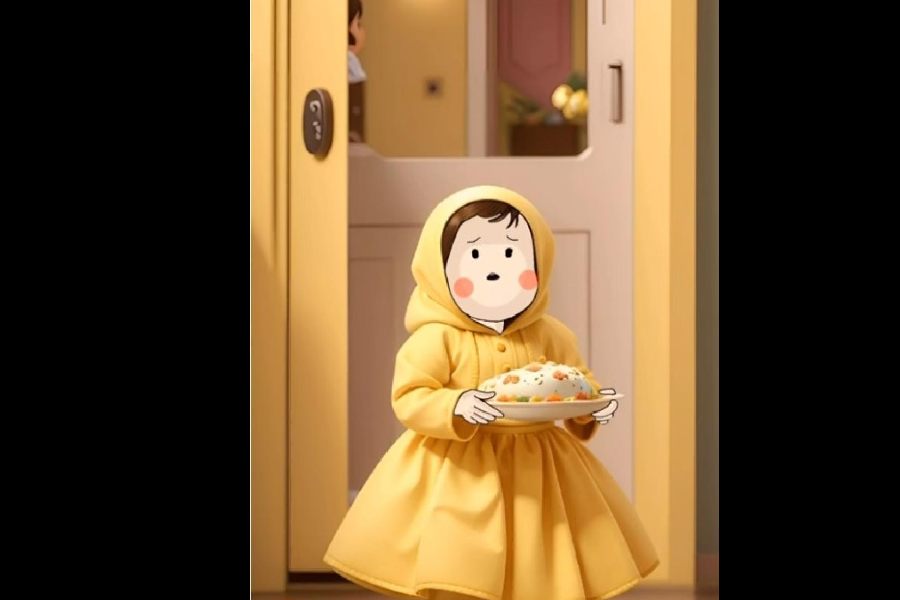Sometimes reels wash up novelties from distant shores. One such is the cartoon exchange between Puchki and Sifu from Bangladesh.
Puchki in Bengali means little one, the -i at the end is to indicate the feminine. Cartoon Puchki is a rosy-cheeked pigtailed brat. Dressed in a polka-dotted frock or sunny burqa paired with a Boho floral headband or in crop top and pyjamas, she spars with Sifu (pronounced si-phoo), who is a young adult (rather good-humoured) male.
Given the degree of indulgence he affords the little tyke, it is safe to surmise that he is either an older cousin or an uncle.
Unlike a Chhota Bheem or Shinchan or Dennis, Puchki is not given to frenetic physical activity; she is quite literally all talk.
Though Puchki is occasionally represented in conversations with her Ammu, a ghost, or the aunty next door, her constant chattermate is Sifu. And her constant refrain in her adorable toddler voice is “Jaano toh, Sifu?”
She holds forth with Sifu on anything and everything. So much so that it
seems more natural to refer to this cartoon as Sifu rather than Puchki, much like how the name Doraemon swallowed up the name of protagonist Nobita.
Doraemon is a Japanese animation series that was hugely popular in India in the early 2000s.
Political animus between nations doesn’t impede conversations about arts and culture. Puchki’s creator, the Rajshahi-based 20-something Arfin Sifat tells The Telegraph in an email chat that Sifu is based on him and Puchki is based on his niece. “My sister’s daughter,” says Sifat, “she is the first spark behind the character, and her real-life energy breathes through every episode.”
Manga series Shinchan’s creator, the late Yoshito Usui, is often quoted as having said, “The character of Shinchan is based on the child I want to be.” Dennis was inspired by the four-year-old son of Hank Ketcham, creator of the cartoon strip Dennis the Menace. Doraemon was created by two Japanese manga artists, Hiroshi Fujimoto and Motoo Abiko. Fujimoto once wrote an essay titled “When I was a child I was Nobita.”
Sifat’s channel on YouTube that hosts this series is called Sifat Cartoon Store. Sifat, however, prefers to call it his “creative label” under which he produces animated shorts and digital content.
Each video has its distinctive theme. It could be a random discussion between Puchki and Sifu about the latter’s fondness for cats or her concept of what a dinosaur is or a nightmare she has had. There are other segments showing the little girl trying to say a grown-up phrase, getting her tongue in knots and chortling at her own inability. During Ramzan, Puchki articulates her struggle to keep fast and on Eid she reveals her industriousness at collecting salami.
Sifat, who is in his early 20s, says he grew up watching Tom and Jerry, Looney Tunes, Doraemon and Meena. The last was popular in India and many other Saarc countries too, but was originally developed by Unicef Bangladesh in the 1990s.
Those who don’t know of Meena, she wore a long shirt and a no-nonsense skirt, tiny gold hoops in both ears and her hair in one never-varying plait. A lot of research went into the creation of this nine-year-old. Artists from different countries drew sketches of South Asian girls and sent those in, and Unicef asked over 10,000 children what clothes Meena should wear. Even the name was chosen keeping in mind that it would be good if it resonated across South Asia.
Puchki is not Meena, who had to fight for her rights. But had it not been for the Meenas, the Puchkis might not have found their voices.
And what a voice Puchki has. She is full of questions — “Why is it called fire service when actually they spray water?” Is she critiquing the ways of the adult world? “If there is a chand mama, why can’t there be a chand mami,” she asks. Is she questioning gender tropes?
The episodes on religious rites and her confusion about what is roja and mistaking sehri for tehri, are they also cute critiques? Those who are familiar with the Bengali language with its wealth of myths and sayings, rhymes and in-jokes will catch glimpses of those in this series.
When Sifu corrects Puchki’s mix-ups, she expresses her displeasure with a loud “chup”. In this role reversal lies the comic effect. Oftentimes she calls him names. Some would say she crosses the line, cuts a Shinchanesque figure. Sifat is aware of this, but says it is his endeavour to strike a balance between entertaining both kids and adults without crossing a line that might make parents uncomfortable.
He adds, “Puchki was created to represent the unapologetic boldness and wit we often find in children around us — especially in Bengali families. I wanted to show a girl who is smart, sharp-tongued and not afraid to speak her mind. That attitude is her superpower.”










